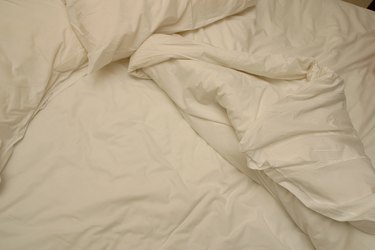
The soft, fluffy layer of down that keeps waterfowl warm also keeps people warm in the form of down-filled comforters. Natural down can also affect allergy sufferers adversely, while other buyers prefer not to use products of animal origin in their bedding. Down alternatives including silk, synthetic fibers and plant-based materials can solve some or all of these concerns.
Weight
Video of the Day
Down exists to insulate warm-blooded creatures from the cold when they fly or swim. Its complex shape traps air as an insulator, so although down weighs little, it insulates effectively. A single ounce of premium goose-down can fill over 800 cubic inches of comforter space. Natural down alternatives weigh more for the same insulating power. Synthetic materials such as polyester and Primaloft now match down's weight and warmth.
Video of the Day
Cost
Down and down alternatives vary in cost according to how much of the material the comforter contains, the quality of the bedding and the manufacturer's name. A thicker comforter with premium down free of prickly feathers costs more than a thinner down comforter or one with a feather blend. Synthetic down alternatives rival down's price and, like the down they emulate, cost more for a thicker comforter. Silk comforters exceed the cost of all but the most expensive down bedding, while wool- and plant-based materials parallel synthetic down alternatives and down in cost.
Care
Down comforters require more delicate care than down alternatives. Cleaning instructions for down-filled bedding vary by manufacturer; some items can go into a home washer and dryer, while others need dry-cleaning. Synthetic down alternative materials typically go right into a standard washing machine without shrinking or migrating. Natural alternatives to down require care similar to natural down. Wool-filled comforters do not typically tolerate home washing, but read manufacturers' instructions on all bedding before deciding how best to keep it clean.
Health
Although manufacturers clean down thoroughly before using the material in bedding, the shape of down's fibers makes it a haven for dust mites. These mites can trigger an allergic reaction in susceptible people. Choosing a down alternative can keep mites out of bedding and lead to more restful, relatively allergy-free sleep. Tiny dust mites thrive best in natural fibers; synthetic fibers provide a less hospitable home for mites. Hypo-allergenic synthetic bedding gives allergy sufferers a down-like option for bedding.